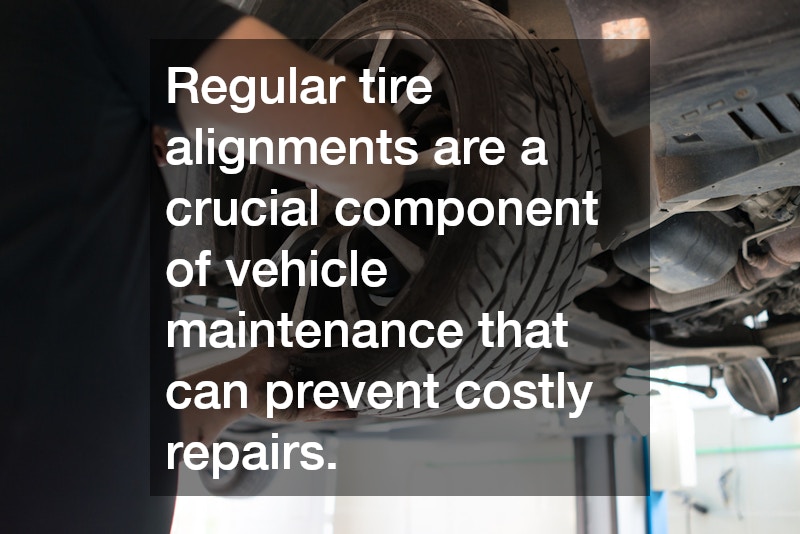Tire misalignment can lead to a host of issues affecting your vehicle’s performance and longevity. Understanding the importance of regular tire alignments can not only enhance your vehicle’s efficiency but also prevent costly future repairs.
Why is Tire Alignment Important?
Improved Fuel Efficiency
Proper tire alignment minimizes rolling resistance, contributing to better fuel economy and reducing fuel costs over time. This alignment ensures that tires are working in harmony and not against each other, which could otherwise increase fuel consumption.
With rising fuel prices, maintaining proper alignment can result in noticeable savings on fuel expenses. Misaligned tires cause the engine to work harder, leading to higher energy consumption and unnecessary stress on vehicle components.
By keeping tires aligned, your vehicle’s aerodynamics remain efficient, further enhancing fuel efficiency. This proactive measure aligns with sustainable practices, reducing your carbon footprint.
Enhanced Vehicle Handling
Aligning your tires ensures optimal handling of your vehicle, enhancing safety and driving comfort. When tires are properly aligned, they provide better grip and control, especially during adverse weather conditions.
Good handling minimizes the risk of accidents as the driver can maneuver the vehicle easily and predictably. Additionally, aligned tires contribute to a smoother ride, reducing stress on both the driver and passengers.
Furthermore, proper alignment ensures that the vehicle’s suspension and steering components are not unnecessarily strained, extending their lifespan. This attention to alignment can lower the cost of more extensive mechanical repairs.
What Are the Signs of Misalignment?
Uneven Tire Wear
Misalignment often leads to uneven tire wear, which can significantly reduce the lifespan of your tires, leading to more frequent replacements. When tires wear unevenly, it alters the balance and stability of the vehicle, impacting overall safety.
Spotting uneven wear patterns early can prevent more serious issues and costs associated with tire replacements. Mechanics often recommend rotating tires regularly to evenly distribute wear, but proper alignment is the fundamental solution.
Ignoring signs of uneven wear might result in a blowout or poor traction, especially in slippery conditions. Maintaining alignment not only ensures longevity but also maximizes performance and safety.
Steering Issues
Common indicators of misalignment include your vehicle pulling to one side and an off-center steering wheel, both of which can affect driving safety. Such issues can cause fatigue and stress during long drives, affecting driver concentration.
When the steering wheel is crooked or if you constantly adjust it to keep the vehicle straight, it’s a clear indication of misalignment. Regular checks and maintenance can avoid the escalation of these issues, ensuring safer driving experiences.
Correct alignment keeps the vehicle on its intended path without requiring constant corrective inputs from the driver. This symbiotic relationship between alignment and steering ensures the vehicle responds reliably and safely to driver commands.
How Often Should Tire Alignment Be Checked?
Regular Maintenance Schedule
Incorporating tire alignment into your annual maintenance routine can preemptively address misalignment issues before they become significant. This preemptive approach saves money by avoiding complex repairs that arise from prolonged neglect.
According to automotive experts, checking tire alignment during routine oil changes or annual inspections is beneficial. Timely adjustments can restore the vehicle’s optimal performance, contributing to extended component life.
Routine alignment checks enhance the comfort and reliability of your vehicle, ensuring safe and economical travel. This practice supports vehicle resilience, reducing the risk of unexpected breakdowns and repair expenses.
Specific Driving Conditions
If you frequently drive on rough or uneven surfaces, it may be necessary to check and align tires more often to maintain vehicle performance. Harsh driving conditions can accelerate misalignment due to continuous shock and stress on the tires.
For those living in areas with uneven road systems or adverse weather conditions, alignment checks take on added importance. Maintaining alignment under such conditions is essential to safeguard against the quick deterioration of tire health.
Frequent checks protect from unintended expenses that arise from ignoring road-born stresses on the tires. Adapting maintenance frequency to driving conditions provides holistic protection for your vehicle’s integrity.
Regular tire alignments are a crucial component of vehicle maintenance that can prevent costly repairs. By ensuring your tires are properly aligned, you can improve fuel efficiency, enhance vehicle handling, and ultimately increase the lifespan of your vehicle’s tires, thereby saving money in the long run.


